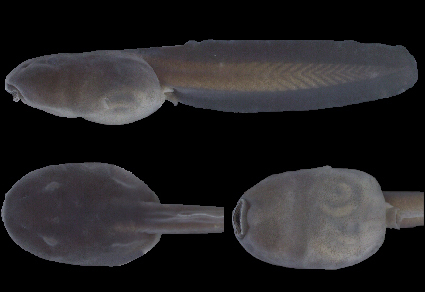References
- Altig, R. & McDiarmid, R.W. (1999) Body plan: development and morphology. In: McDiarmid, R.W. & Altig, R. (Eds.), Tadpoles: The Biology of Anuran Larvae. The University of Chicago Press, Chicago, Illinois, pp. 24−51.
- Avila-Pires, T.C.S., Hoogmoed, M.S. & Rocha, W.A. (2010) Notes on the vertebrates of northern Pará, Brazil: a forgotten part of the Guianan Region, I. Herpetofauna. Boletim do Museu Paraense Emílio Goeldi Ciências Naturais, 5, 13–112. https://doi.org/10.46357/bcnaturais.v5i1.647
- Born, M.G. (1994) The poison arrow frog Dendrobates tinctorius in the tropical rainforest of French Guiana, microhabitat and feeding ecology. Unpublished M.Sc. Dissertation. Forest Ecology and Forest Management Group, Center for Ecosystem Studies, Wageningen University, Wageningen. [unknown pagination]
- Born, M.G., Bongers, F., Poelman, E.H. & Sterck, F.J. (2010) Dry‑season retreat and dietary shift of the dart‑poison frog Dendrobates tinctorius (Anura: Dendrobatidae). Phyllomedusa, 9, 37–52. https://doi.org/10.11606/issn.2316-9079.v9i1p37-52
- Caldwell, J.P. & Araújo, M.C. (2004) Historical and ecological factors influence survivorship in two clades of phytotelm-breeding frogs (Anura: Bufonidae, Dendrobatidae). Miscellaneous Publications Museum of Zoology University of Michigan, 193, 11–21.
- Dias, P.H.S., Araujo-Vieira, K., Carvalho-e-Silva, A.M.P.T. & Orrico, V.D. (2019) Larval anatomy of Dendropsophus decipiens (A. Lutz 1925) (Anura: Hylidae: Dendropsophini) with considerations to larvae of this genus. PlosOne, 14, e0219716. https://doi.org/10.1371/journal.pone.0219716
- Dias, P.H.S. & Pie, M.R. (2021) Buccopharyngeal morphology of the tadpoles of Scinax v-signatus, with comments on larval characters of the S. perpusillus species group (Amphibia: Anura: Hylidae). Zootaxa, 4694 (1), 195–200. https://doi.org/10.11646/zootaxa.4964.1.12
- Duarte-Marín, S., González-Acosta, C.C., Santos Dias, P.H., Arias-Álvarez, G.A. & Vargas-Salinas, F. (2020) Advertisement call, tadpole morphology, and other natural history aspects of the threatened poison frog Andinobates daleswansoni (Dendrobatidae). Journal of Natural History, 54, 3005–3030. https://doi.org/10.1080/00222933.2021.1889068
- Frost, D.R. (2023) Amphibian species of the world: an online reference. Version 6.0. Available from: http://research.amnh.org/herpetology/amphibia/index.html (accessed 3 March 2023)
- Gosner, K.L. (1960) A simplified table for staging anuran embryos and larvae with notes on identification. Herpetologica, 16, 183–190.
- Grant, T., Rada, M., Anganoy-Criollo, M., Batista, A., Dias, P.H., Jeckel, A.M., Machado, D.J. & Rueda-Almonacid, J.V. (2017) Phylogenetic systematics of dart-poison frogs and their relatives revisited (Anura: Dendrobatoidea). South American Journal of Herpetology, 12, 1–90. https://doi.org/10.2994/SAJH-D-17-00017.1
- Haas, A. (2003) Phylogeny of frogs as inferred from primarily larval characters (Amphibia: Anura). Cladistics, 19, 23–89. https://doi.org/10.1016/S0748-3007(03)00006-9
- Hoogmoed, M.S. (1969) Notes on the herpetofauna of Surinam III. A new species of Dendrobates (Amphibia Salientia, Dendrobatidae). Zoologische Mededelingen, Leiden, 44, 133–141.
- Kaplan, M. (1997) A new species of Colostethus from the Sierra Nevada de Santa Marta (Colombia) with comments on intergeneric relationships within Dendrobatidae. Journal of Herpetology, 31, 369–373. https://doi.org/10.2307/1565665
- Lannoo, M.J., Townsed, D.S. & Wassersug, R.J. (1987) Larval life in the leaves: arboreal tadpoles types, with special attention to the morphology, ecology, and behavior of oophagous Osteopilus brunneus (Hylidae) larvae. Fieldiana, 38, 1–31. https://doi.org/10.5962/bhl.title.2932
- Lavilla, E.O. & Scrocchi, G.J. (1986) Mofometría larval de los géneros de Telmatobiinae (Anura: Leptodactylidae) de Argentina y Chile. Physis, 44, 39–43.
- Lehtinen, R.M., Lannoo, M.J. & Wassersug, R.J. (2004) Phytotelm-breeding anurans: past, present and future research. Miscellaneous Publications. Museum of Zoology, University of Michigan, 193, 1–9.
- Lescure, J. (1984) Las larvas de Dendrobatidae. Reunión Iberoamericana de Conservación y Zoología de Vertebrados, Actas II, 1984, 37–45.
- Lins, A.C., De Magalhaes, R.F., Costa, R.N., Brandão, R.A., Py-Daniel, T.R., Miranda, N.E., Maciel, N.M., Nomura, F. & Pezzuti, T.L. (2018) The larvae of two species of Bokermannohyla (Anura, Hylidae, Cophomantini) endemic to the highlands of central Brazil. Zootaxa, 4527 (4), 501–20. https://doi.org/10.11646/zootaxa.4527.4.3
- Masurat, G. & Wolf-Rudiger, G. (1991) Lurche. Vermehrung von Terrarientieren. Urania-Verlag, Leipzig, 164 pp.
- Rojas, B. & Pašukonis, A. (2019) From habitat use to social behavior: natural history of a voiceless poison frog, Dendrobates tinctorius. PeerJ, 7, e7648. https://doi.org/10.7717/peerj.7648
- Satel, S.L. & Wassersug, R.J. (1981) On the relative size of buccal floor depressor and elevator musculature in tadpoles. Copeia, 1981, 129–137. https://doi.org/10.2307/1444047
- Silverstone, P.A. (1975) A revision of the poison-arrow frogs of the genus Dendrobates Wagler. Natural History Museum of Los Angeles County Science Bulletin, 21, 1–55.
- Taucce, P.P., Costa-Campos, C.E., Carvalho, T.R. & Michalski, F. (2022) Anurans (Amphibia: Anura) of the Brazilian state of Amapá, eastern Amazonia: species diversity and knowledge gaps. European Journal of Taxonomy, 836, 96–130. https://doi.org/10.5852/ejt.2022.836.1919
- Wollenberg, K.C., Lötters, S., Mora-Ferrer, C. & Veith, M. (2008) Disentangling composite colour patterns in a poison frog species. Biological Journal of the Linnean Society, 93, 433–444. https://doi.org/10.1111/j.1095-8312.2007.00906.x


